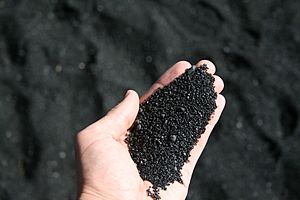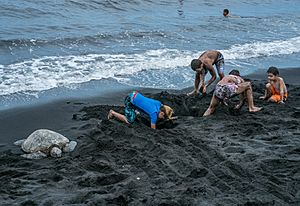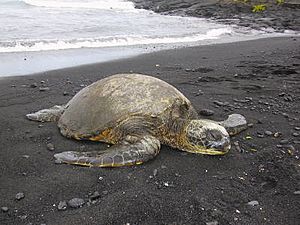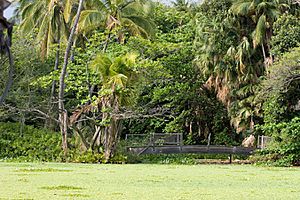Punaluʻu Beach facts for kids
Punaluʻu Beach (also known as Black Sand Beach) is a famous beach on the Big Island of Hawaii. You can find it between the towns of Pāhala and Nāʻālehu.
The beach gets its name from its unique black sand. This sand is made of a dark rock called basalt. It forms when hot lava from volcanoes like those in Hawaii Volcanoes National Park flows into the ocean. When the super hot lava hits the cool ocean water, it explodes and breaks into tiny pieces, which then cool down and become black sand.
Punaluʻu Beach is a special place for animals. You can often see endangered hawksbill and green turtles resting on the warm black sand. They love to bask in the sun here!
Contents
Exploring Punaluʻu Beach
Swimming at Punaluʻu Beach can be tricky because it's very rocky. It's important to be careful if you decide to go into the water.
A cool fact about this beach is that a lot of fresh water flows into it from underground. This fresh water is very cold and can look a bit like oil mixing with the ocean water. An old Hawaiian story says that during dry times, ancient Hawaiians would dive underwater with a jug to collect this fresh water. The name Punaluʻu in the Hawaiian language actually means "spring [water] diver for."
You can find Punaluʻu Beach by taking the Ninole loop road or the entrance to the Sea Mountain Resort from the Hawaii Belt Road. If you like camping, you're in luck! Camping is allowed at the Punaluʻu Black Sand Beach Park.
Ancient Hawaiian History at Punaluʻu

Punaluʻu and the areas around it are full of history. You can see how sacred places have changed over time. Long ago, powerful Hawaiian chiefs, called aliʻi, built large stone temples called heiau here. These temples show how important and organized ancient Hawaiian society was.
Later, Christian missionaries arrived in Hawaii, starting in 1833. They also built churches that became important landmarks. One such church is Hōkūloa Church, which sits on a ridge above Punaluʻu. It's a memorial chapel and graveyard built near the birthplace of Henry ʻŌpūkahaʻia (1792–1818). He was a Hawaiian who inspired many missionaries to come to Hawaii and changed the islands forever.
There are three ancient heiau (temples) very close to Punaluʻu. Some of these temples, with their stone walls, were built around 1100 AD. Punaluʻu is one of the few places in Hawaii where you can still see these temples without modern buildings blocking the view between them.
Important Heiau Sites
To the south of Punaluʻu is Kaʻieʻie Heiau. People believe it was a fishing shrine. It was built on a high cliff overlooking the ocean. From here, ancient Hawaiians could see fishponds and Koloa Bay. Koloa Bay was known for its special "birthing stones" (na ʻiliʻili hanau). These smooth, water-polished stones were thought to have magical powers to create more stones. They were used to pave temples, as slingshot ammo, and for a Hawaiian game called konane.
Another large heiau complex called Lanipau was partly covered when the Sea Mountain Resort golf course was built. Today, only a small part of it remains, like an "island" surrounded by golf greens.
The heiau overlooking Punaluʻu Beach has many names, including Halelau and Punaluʻu Nui. This temple likely reached the edge of the cliff. Part of it was destroyed in 1906 to build a wharf for a sugar company. This heiau was a heiau luakini, which means it was a temple where human sacrifices might have taken place. A large, table-like stone outside its southern wall is known as Pohaku Mohai, or "sacrificial stone."
Ancient Trails and Carvings
An important cultural path is Ala Kahakai, which means "trail by the sea." This trail connected important religious centers and coastal villages. It was believed to be the path taken by the Hawaiian god Lono. This trail, once paved with the special birthing stones, became a National Historic Trail in 2000. You can still find parts of it near the Punaluʻu Nui and Kaʻieʻie heiau.
You can also find ancient rock carvings, called kiʻi pohaku (petroglyphs), near the County Park Pavilions. They are in a protected area surrounded by a rock wall, just past the parking lot. These old carvings are easy to miss, so keep an eye out for them!
Animals at Punaluʻu Beach
Punaluʻu and the nearby Ninole area are home to many rare and endangered native animals.
Sea Turtles
You can often see the honu ea (hawksbill turtle) and honu (green turtle) here. The hawksbill turtle is very rare, with fewer than 80 nesting turtles in all of Hawaii. More than half of them nest near Hawaii Volcanoes National Park, close to Punaluʻu.
The green turtle is more common and loves to eat marine plants in the shallow waters. Red seaweed, a favorite food, grows on the rocks in the bay. Even with people on the beach, the turtles often come ashore to rest on the black sand. Remember to stay at least 15 feet (about 4.5 meters) away from the turtles at all times to keep them safe!
Other Rare Animals
Sometimes, you might even spot a Hawaiian monk seal resting on the beach or Spinner dolphins and humpback whales swimming offshore. These sightings show that the environment here is healthy and has enough food for these large marine animals.
The endangered Hawaiian hoary bat, called ʻōpeʻapeʻa, also lives and flies over Punaluʻu. These bats are nocturnal, meaning they are active at night, and they eat insects. Not much is known about these unique Hawaiian bats.
One of the largest groups of the rare orange-black damselfly can be found in Ninole. These insects are also endangered and live in the watery areas fed by springs.
Plants at Punaluʻu
The plants along the coast at Punaluʻu grow in a narrow strip. You'll see different shrubs, vines, grass-like plants, and scattered trees. The varied landscape, with smooth lava (pāhoehoe), rough lava (ʻaʻā) flats, sand, and pools, supports different native plants. Some native plants found here include ilima (a type of shrub), naupaka kahakai (beach cabbage), and pōhuehue (beach morning glory).
Wetlands and Anchialine Pools
Punaluʻu and Ninole Cove have the second largest spring complex on the Big Island. These areas are wetlands fed by springs and streams. They are home to many native animals, especially young marine animals like fish and invertebrates. This suggests the area is an important nursery for sea life.
What are Anchialine Pools?
Anchialine pools are special pools of brackish water (a mix of fresh and salt water) found near the coast. They are connected to the ocean underground, so their water levels change with the tides, even though they don't have a surface connection to the sea. These pools are very rare and are often found in collapsed lava tubes or cracks.
Unique shrimp species live in these pools and travel through underground tunnels. The orange-black damselfly also breeds in these pools. Unfortunately, these special pools are threatened by new insect species, coastal building, and other human activities. In the U.S., these pools are only found in Hawaii. Most of the known 700 anchialine pools are on the Big Island.
Koa: Natural Fish Houses
Punaluʻu is also known for its koa, which means "fish houses." These are specific areas offshore where certain types of fish live. The mix of fresh spring water from the land and salt water from the ocean creates a perfect home for many fish. Local fishermen still use several of these natural koa offshore from Punaluʻu. Each koa is known for the type of fish found there, like yellowfin tuna (ahi) and mackerel (ono).
In the past, Hawaiian families would feed the fish in the koa with cooked taro and pumpkin. In return, the fish would provide a steady source of food for the families.
Development History
A golf course was built near Punaluʻu between 1969 and 1972. Later, in 1986, there were plans for a much larger resort. People living nearby were against it, so the plans were made smaller. Some parts of the project were built, but it was eventually stopped.
In 2005, a new development called "Sea Mountain" was proposed. It would have included up to 2000 homes. This plan also faced strong local opposition and was not completed.
See also
 In Spanish: Punaluu Black Sand Beach para niños
In Spanish: Punaluu Black Sand Beach para niños





